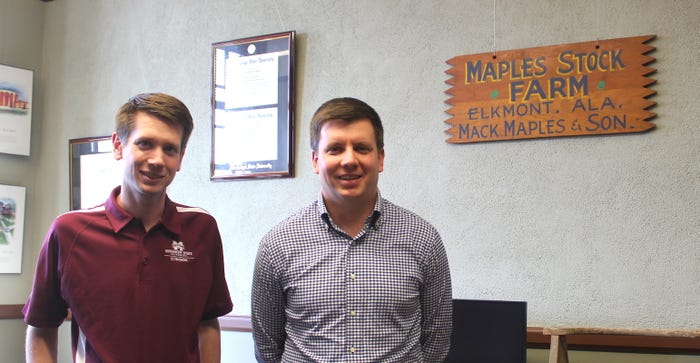
It’s been said that 2021 is a good year to be a farmer.
It’s not a bad time to be an Extension economist, either.
“Strong prices and demand have certainly made the outlook talks a lot more fun,” Josh Maples said.
Maples is an assistant professor and livestock economist with Mississippi State University Extension Service. We sat down with him to discuss the past year and economic outlook for beef cattle markets in 2022. We were joined by Will Maples, a fellow MSU Extension economist. Will specializes in row crops. He also happens to be Josh’s younger brother.
“There’s a lot of optimism in agriculture right now,” said Will. “That’s not to say there aren’t challenges and concerns, but it’s good to see producers be encouraged by the markets.”
Row crops outlook
While producers have seen strong grain and cotton prices this year, the big question as we head into 2022 is how long will the good times last?
“As we watch the markets, nothing is saying next year is going to be bad by any stretch pricewise,” Will said. “Demand is still good. We’re still exporting a lot of beans and corn. Cotton is over $1, which we haven’t seen in years. Long-term, I think demand is going to hold. Going into next year I think prices are going to remain strong.”
“But with fertilizer prices through the roof, equipment costs being up, chemical costs being up, it’s a good year to have good prices because those margins are going to get squeezed pretty tight,” he added.

With input prices already high, Will said there is little producers can do to manage the risk of rising expenses.
“One thing for row crop producers to consider is soil testing,” he said. “Soil testing will pay off this year because growers can’t afford to needlessly apply fertilizer and soil amendments. That’s the first step.”
“Crop mix decisions will be more dynamic this year than normal. I’ve heard some conversation about shifting crop mix — moving away from a fertilizer-intensive crop like corn. But if you look at current prices, corn is still looking just as good as soybeans. When making crop decisions growers need to carefully evaluate prices versus costs. Really understand what costs are going to be and how to be profitable,” he said.
Despite input cost concerns, Will is optimistic about 2022.
“Market wise I think it’s going to be pretty good. We’re past the trade war. Export markets are back to normal. $5 corn and $12 beans should be attainable. It’s just the inputs. The inputs right now are the big question mark. But even with increased costs, prices are there to make a profit.”
Beef outlook
After two really tough years, Josh said the current beef outlook is positive, as well. Thanks to a tightening supply, beef producers may finally be able to participate in high beef prices.
“Processing disruptions caused by COVID created a logjam,” he said. “Consumers saw high beef prices, but cattle prices actually dropped because they got backed up through the system. But we’re getting back to a point where cattle supplies are a lot more current. The number of cattle in feed lots has come down quite a bit.”

Although feedlot inventories remain above 2019 levels, overall, the feedlot situation continues to improve. Meanwhile, beef demand has been incredible. Josh’s optimism is fueled by high beef cattle slaughter numbers — which are currently higher than this time last year and any time in the past five-year average.
“If you’re processing more cows that means one of two things. You’re either culling early or you’re doing some true liquidation. I think over the next few weeks we’ll get our answer. It could be because of the drought out West we’re just seeing producers cull earlier than normal. If that’s the case, then over the next month or two, when we typically see slaughter numbers hit their peak, we shouldn’t see as much of an increase. If we continue to see really strong slaughter numbers, that will tell us we’re going to have even tighter supplies next year than previously expected. We could be looking at 2% decline of beef cows in the U.S. in January,” he said.
“Producers are optimistic in terms of prices,” Josh continued. “Anytime you have strong demand with a tight supply of cattle, that’s when you can see strong prices. We have spring cattle futures at levels we haven’t seen in five to six years, so there is a lot of optimism out there. Until someone brings up input prices.”
Josh said he expects to see less winter ryegrass this year due to high fertilizer costs.
“The good news is we didn’t have a dry year so most producers have grass to feed,” he said.
Risk management
While current commodity prices are good, markets can change quickly. Josh and Will suggest that producers know what tools they have available and put a marketing plan into place.
“Sit down this winter and make sure you have a marketing plan in place,” Will said. “Know what prices you need to be profitable. If the market gives you that, take it.”
Will encourages growers to use MSU’s online budget planning tools. The site offers budgets for each major crop grown in Mississippi, as well as forages. Budget tools will be updated with current prices and costs in November 2021.
“For cattle producers, risk management is especially important as we get into the spring,” Josh said. “If your herd is calving in January or February, think about doing some risk management during that springtime. I always encourage producers to pay attention to what’s going on in the markets. If you see prices that are well above your break-even and you can, take it, don’t get caught waiting for prices to get higher and higher.”
Josh said farmers should consider using a variety of marketing tools to spread their risk.
“There are a ton of different strategies. Everyone needs something a little different,” he said. “The most important thing is having a plan before you start. Producers who are good at marketing are those who start with a plan and stick to it. The lucky ones are those who just go for it when something pops up. That my serve you well in some years, but mostly if you go into it without a plan and instead have this “wait and see” mentality, problems can occur.
“Marketing is often an area where many producers feel like they need more information, but as long as you’re staying in business and profitable, then you are doing a lot right on the marketing side of the operation,” Will added. “A written crop marketing plan helps reduce second guessing.”

Family business
While it’s the job of an economist to monitor trends and develop market forecasts, the Mapels brothers never predicted they would end up working for the same university, in the same department, with offices next door to each other no less.
“We’ve always been really close. Growing up on our family farm in Elkmont, Ala., we both knew we wanted to work in agriculture in some capacity,” said Josh. “The way it worked out was just a lucky break. Our parents love it because we both found positions at the land-grant university closest to our hometown.”
Josh joined MSU’s Department of Agricultural Economics in 2017. Two years later, younger brother Will came on board. Besides being called by the other brother’s name from time to time (something they say has happened most of their lives) or receiving emails from students addressed to the wrong Dr. Maples, the siblings say the work situation has been good.
“Working with different commodities, we don’t collaborate as much as you would expect,” Will said. “We mostly work in different circles with different people.”
“But it’s helpful, because the two sectors are so linked, and we can talk to each other,” Josh adds. “If something is happening in the cattle markets, I can go next door and find out from Will what’s going on in the grain markets. It’s great to be able to do that.”
About the Author(s)
You May Also Like






